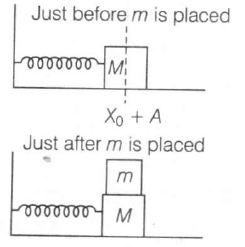Answer:
Option A,B,D
Explanation:
Case-1

Case -II

In caes-I
$Mv_{1}=(M+m)v_{2}\Rightarrow v_{2}=(\frac{M}{M+m})v_{1}$
$\sqrt{\frac{k}{M+m}}A_{2}=(\frac{M}{M+m})\sqrt{\frac{k}{M}}A_{1}$
$A_{2}=\sqrt{\frac{k}{M+m}}A_{1}$
In case-2, $A_{2}=A_{1}$
$T=2\pi \sqrt{\frac{M+m}{k}}$ in both cases.
Total energy decreases in first case whereas remain same in 2nd case. Instantaneous speed at x0 decreases in both cases.